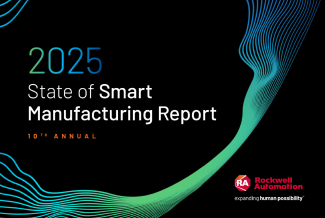

Now Available!
Get your copy of the 7th Annual State of Smart Manufacturing and hear from 300+ manufacturers in this new survey report!

Please complete the form to view
Take Control of Your Manufacturing Business Software
A cloud ERP system can deliver great benefits and support lean, efficient, and effective operations. But many manufacturers aren't getting the return they need from their investment in ERP. In today's demanding manufacturing environment, an ineffective ERP system can hold back your business.
Download this paper to:
- Explore how you can eliminate complexity, duplication of effort, and even poor quality and ineffective customer service.
- Understand how to face challenges such as rising material costs, increasing competition, and ever-changing customer requirements.
- Take control with a new approach to business systems.
At A Glance

"The Plex Smart Manufacturing Platform integrates and streamlines all aspects of a manufacturing company, including sales, engineering, quality management, production, scheduling, shop floor control, barcoding, part traceability, warranty tracking, shipping and receiving, EDI, human resources, tooling, and more"
Why Do ERP and MES Systems Fall Short? Manufacturers expect their ERP or MES systems to improve their company’s performance. In most cases the original goals for implementing a new system were to streamline and simplify their business processes while keeping their competitive advantage.
In a lot of cases, ERP and MES software implementations miss their mark. Instead of delivering what was promised in terms of cost reduction, increased agility and performance, they add complexity, effort duplication and negatively impact quality and customer service.
Legacy ERP and MES systems can’t keep up with the evolution of the manufacturing industry and new regulatory requirements. Manufacturers need to change their business processes, how they analyze data and execute, but are often held back by inflexible ERP and MES systems that are not matched with what the business needs.
The Warning Signs
Look through these ten warning signs to see if your ERP and MES systems are killing your business.
1. Your ERP and MES Systems Can't Integrate Critical Business Data
You can’t make smart business decisions because your data is hard to access and analyze with you current legacy system.
Even worse you don’t have a pulse on quality management, engineering, design and your customer orders or any aspect of your production, because the information is siloed and independent of each other.
Having all of this disconnected unreliable data increases the likelihood that your are duplicating efforts and compromising quality.
2. Changes to the System are Costly and Time-Consuming
The software vendor issues releases every 12-24 months and rarely provides the new features you need on a timely basis. Any change coming from the vendor seems to cost you six figures and many months to complete. You are having a hard time finding the right resources to help at an affordable rate, so you are stuck with an outdated system that is not providing an ROI.
Industry analysts see this as a bad sign, as noted in an Aberdeen Group study, cosponsored by Plex. “While it may be acceptable to skip a release or run one release behind the most currently available, lagging significantly behind on an ERP and MES implementation will leave functionality and technology improvements largely unused. Not taking advantage of new releases can mean losing a competitive advantage and wasting the money paid in maintenance fees.”
3. Your Disaster Recovery Plan is Dependent on Tapes
Imagine if your servers and data centers burned down. You will have to buy new equipment, configure it and hope that you can recover all of your data from tapes. Your Recovery Point Objective (RPO) doesn’t give you confidence because you are relying on tapes that may or may not contain all of the data you need to run your business.
This process is timely and requires lots of resources which means it impacts your Recovery Time Objective (RTO) to get back up and running. It slows your production or even worse, brings it to a complete standstill.
4. Beefy PCS or "Fat Clients" are Needed to Run the System
Sure PCs are getting cheaper, but they are running less memory. If you need to install and maintain fat clients (a networked computer with most resources installed locally, rather than distributed over a network), you run into IT management difficulties, security risks, and high maintenance and licensing costs.
5. Maintenance Fees are High
With rising ERP and MES solutions’ maintenance fees, you can’t control your IT costs. Some of the biggest software vendors often raise their maintenance fees as much as 22% of the original license cost. In order to predict how much your IT costs are increasing, you need to keep a close eye on multiple support contracts for applications and information that are not connected. Also technical differences across multiple applications, require hiring experts to implement and manage them all.
6. You Can't Access the Data Easily If You are Traveling
It’s obvious that business doesn’t stop when you are traveling. Smartphones help you stay in touch, but if your ERP and MES systems don’t have mobile apps, you’re out of luck. Wireless connectivity is everywhere, yet you’re limited because you can’t stay in touch with business operations.
7. Upgrades are Disruptive to the Business
We already noted that upgrades from software vendors usually come out every 12–24 months on average. They often require updates to the operating system, database management system, disk space, hardware, etc. Upgrades take time to plan and to execute. You’re in trouble if the business has to be ”down” for a period of time to do the conversion.
8. Trading Partners Can't Easily Interact With the System
In today’s modern manufacturing industry, the value stream is interconnected and real time replenishment is a requirement which means suppliers need easy access to your orders and inventory levels.
9. New Employees Need Time to Learn the System
Legacy ERP and MES systems are difficult to learn and workers are easily frustrated when they are instructed to “Press F1 to inquire” or “Press Enter to accept”. You lose money while the new people have to spend more time to learn the system and get up and running. Imagine how that impacts your production time.
10. Globalization is Too Difficult
Many legacy systems require you to run a different version to support China, Eastern Europe, or various countries. Changes to the translation are difficult, if possible at all. Rollups of localized, unique financial data are done via spreadsheets, which is cumbersome. This is unacceptable in today’s modern and global marketplace.
The Next Step
Fortunately, a new breed of ERP and MES resolves these challenges so manufacturers can thrive by doing what they do best, not writing and maintaining software.
The Plex Smart Manufacturing Platform offers robust ERP and MES functionality without the need for expensive servers, operating systems, database software, backup equipment, and the IT specialists to manage all of that. It is always up to date and is available to customers via a monthly subscription fee. That means no hassle, business disruption, or costs with version upgrades.
The Plex Smart Manufacturing Platform integrates and streamlines all aspects of a manufacturing company, including sales, engineering, quality management, production, scheduling, shop floor control, barcoding, part traceability, warranty tracking, shipping and receiving, EDI, human resources, tooling, and more.
Because you don’t have to invest in servers or overhaul your IT infrastructure, you will reduce costs and improve quality and production across your organization.
The Smart Manufacturing Platform Difference
The Plex Smart Manufacturing Platform is a digital system of record that connects people, systems, machines, and supply chains, automates business processes, tracks data from the shop floor to the top floor, and delivers analytics for unmatched visibility and control.
Because it is internet based and device agnostic, it eliminates the need to purchase special hardware or overhaul your infrastructure.
It is ideal for managing multiple plants and connecting you to your customers and suppliers in a centralized platform with real time information no matter where they are in the world. With an uptime of 99.9%, it means the platform is always available.
It provides integrated localization capabilities to manage business requirements from manufacturers operating in the global economy. The platform easily incorporates and manages data in multiple languages, currencies, and date formats, including local tax and business mandates and other business requirements unique to a specific country or municipality.
And finally, the platform meets key targets for data continuity and disaster recovery. Plex delivers aggressive recovery point objective (RPO) and recovery time objective along an uptime of 99.9%. The targets are in line with the world’s leading technology providers for continuity and disaster recovery planning. This means your company can be up and running within two hours of a disaster with data that is no older than two hours. This approach delivers a level of responsiveness, redundancy, and safety for manufacturers that is virtually impossible for them to match internally.



